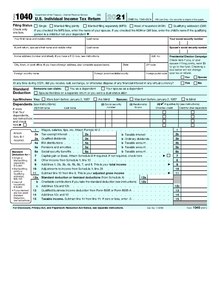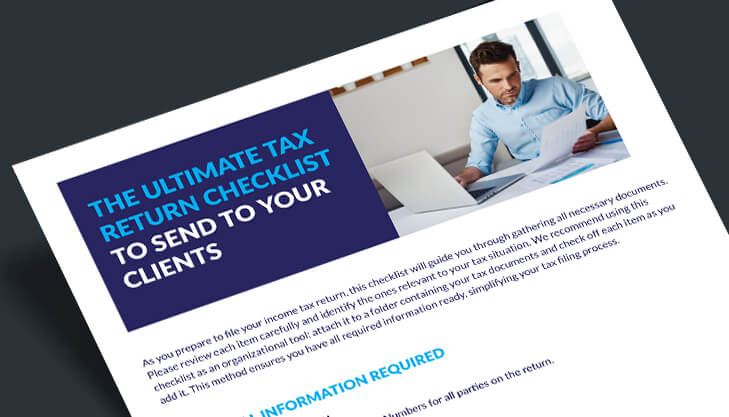
The Complete Guide to Understanding Form 1040

Benjamin Franklin may have talked about death and taxes, but he omitted to mention Form 1040. Good thing you can outsource tax preparation services and avoid the hassle.
- Who is required to file Form 1040?
- Completing Form 1040 for CPAs
- Deadline for Filing Form 1040 and Extensions for CPAs
- Schedules Used with the Form 1040 for CPAs
- Individual Tax Returns and the Form 1040 for CPAs
- Understanding Schedules for the Form 1040 for CPAs
- Schedule C: Business Profit or Loss for CPAs
- Schedule SE: Calculation of Self-Employment Tax
- Essential Information Needed by CPAs for Completing Form 1040
- FINAL THOUGHTS
In America, all taxpayers must file a Form 1040 annually. 1040 is the only tax form required to be filed by all American taxpayers. As a CPA, it is important to educate your clients on the importance of timely and accurate filing of their tax returns in the form of 1040.

This form reflects an individual’s income, deductions, and credits and helps determine the amount of tax they owe or the refund they are eligible for. By understanding the various parts of the form, you can assist your clients in making informed decisions about their tax planning and preparation. In addition, you can help them identify potential tax savings and avoid any errors or mistakes that could result in fines or penalties. Filing a tax return in the form of a 1040 is not just a legal obligation but also a valuable tool for managing one’s finances and achieving financial goals.
Form 1040, also known as the U.S. Individual Tax Return, is an essential document for taxpayers in the United States. As CPAs and accounting firm owners, it is critical for you to have a deep understanding of this form and its various types. Form 1040 serves as the primary means for taxpayers to report their income to the Internal Revenue Service (IRS) and calculate their federal income tax liability.
With the changing tax regulations and new reporting requirements, CPAs and professionals in the accounting industry need to stay up-to-date and knowledgeable about Form 1040. This guide aims to provide you with a comprehensive overview of Form 1040, including its purpose, types, and use. With this information, you’ll be equipped to provide your clients with the best tax guidance and services while ensuring compliance with the latest tax regulations. Whether you’re a seasoned professional or just starting, this guide is a valuable resource that will help you navigate the complexities of Form 1040.
The IRS Form 1040 is a standard tax form used to report an individual’s taxable income in the United States. The form is used by all taxpayers, regardless of their source of income or financial status. It is important to note that the 1040 form is not the only form required for individual income tax returns. Depending on the taxpayer’s circumstances, additional forms, such as W-2s, 1099s, and Schedules, may need to be submitted.
Who is required to file Form 1040?
According to the IRS, all individuals with taxable income must file a tax return using the appropriate form, with the 1040 form serving as the universal form for individual taxpayers. Depending on a taxpayer’s income and employment status, additional schedules and forms may be necessary, but 1040 remains the cornerstone of personal tax filings. CPAs must thoroughly understand the requirements for the 1040 form to guide their clients through the tax filing process accurately.
Completing Form 1040 for CPAs
As a CPA, it is important to understand the requirements for completing Form 1040. The first section requires listing all sources of taxable income, including wages and salaries, tips, interest, dividends, taxable refunds, taxable alimony, business income, unemployment, retirement distributions, and social security benefits. Any income that does not fit into one of these categories can be listed under “other income.”
To calculate the adjusted gross income (AGI), subtract eligible deductions from the gross income. The AGI can be reduced further by claiming eligible tax credits, which should be applied before completing Form 1040.
Once the AGI has been calculated, use the tax tables on Form 1040 to determine the amount of taxes owed. Before preparing the return, make sure to include any deductions and credits. The form can be filed electronically or via mail, along with any tax payment that may be due.
- Gather Client Information: Collect all necessary documents, including W-2s, 1099s, and other income records.
- Choose the Correct Filing Status: Determine the most beneficial filing status for your client.
- Report Income Accurately: Enter all income sources on the appropriate lines of the form.
- Claim Deductions and Credits: Identify and apply eligible deductions and credits to reduce taxable income.
- Calculate Taxes Owed or Refund: Use the tax tables to determine the client’s tax liability or refund.
- Check for Errors: Review the form for any mistakes or missing information to avoid delays.
- Sign and File: Ensure the client signs the form and files electronically or by mail by the deadline.
THE ULTIMATE TAX RETURN CHECKLIST TO SEND TO YOUR CLIENTS
A Handy Guide for CPAs to Facilitate Clear Client Communication This Tax Season
Download Free Guidedownload
Deadline for Filing Form 1040 and Extensions for CPAs
As a CPA, it’s important to know that the deadline for filing individual tax returns and paying any taxes owed is April 15th. If this due date falls on a weekend or holiday, it is extended to the next business day. If an extension is needed, it can be requested by filing Form 4868, which provides an additional six months to file the return. It’s worth noting that any taxes owed are still due on April 15th, regardless of the extension. In the case of the inability to pay taxes on time, a payment plan or an IRS instalment agreement may be an option.
Schedules Used with the Form 1040 for CPAs
As a CPA, you may encounter clients who need to complete additional Schedules when filing the 1040 Form. To ensure a complete and accurate tax return, it’s essential to follow the instructions provided with the 1040 Form. In most cases, freelancers must attach Schedule C to their 1040 Form, but not all taxpayers will be required to attach a Schedule.
Individual Tax Returns and the Form 1040 for CPAs
It is a requirement for all taxpayers to complete the 1040 Form during tax season. All taxpayers can use the same form, so your clients are not alone in this process. The only exception to this rule is for non-resident aliens, who must use the 1040-NR form instead. The 1040-ES form is used for paying quarterly taxes, but the most commonly used form is the 1040 Form, which requires the most information.
Understanding Schedules for the Form 1040 for CPAs
As a CPA, it’s important to understand the 1040 Form and its accompanying Schedules. To ensure a complete and accurate tax return, following the instructions provided with the 1040 Form is crucial. Additional Schedules may be required along with the 1040 Form, but not all taxpayers will need to attach them. In general, freelancers must at least attach Schedule C to their 1040 Form.
Schedule C: Business Profit or Loss for CPAs
As a CPA, you are likely familiar with the importance of accurately reporting business financial information on tax returns. You will need to use Form Schedule C to report the profit or loss from a client’s business.
This form is an important tool for maximizing tax deductions and reducing the amount of taxes owed to clients who are sole proprietors or single business owners. A sole proprietor is an unincorporated business owned by a single person responsible for the profits earned and taxes paid on those profits. Examples of sole proprietorships include catering companies, tutoring services, computer repair services, house cleaning services, and landscaping businesses.
Schedule C is divided into five sections: income, expenses, costs of goods sold, information on the client’s vehicle, and other expenses. You will use this information to determine the client’s business profit and the taxes owed, which will then be reported to the IRS. Attaching Schedule SE (Self Employment Tax) and the 1040 form is important when submitting Schedule C.
Schedule SE: Calculation of Self-Employment Tax
Self-employed or freelancers must pay self-employment tax on their total income exceeding $400, as required by the IRS.
Schedule SE calculates this tax, which encompasses Medicare and Social Security taxes, which are mandatory for all taxpayers to pay.
Essential Information Needed by CPAs for Completing Form 1040
CPAs will need the following information to complete their clients’ Form 1040:
- Personal Information: Name, address, Social Security number, and filing status
- Income: Wages, salaries, tips, unemployment compensation, and any other forms of taxable income
- Deductions: Itemized deductions or the standard deduction
- Credits: Tax credits, such as child tax credits, education credits, and retirement savings contributions credits
- Business Income: Any business income or loss
- Investment Income: Interest, dividends, and capital gains or losses
- Retirement Income: Distributions from retirement accounts, such as pensions and annuities
- Social Security Benefits: Any Social Security benefits received
- Health Savings Accounts: Contributions and distributions from Health Savings Accounts (HSAs)
- Other Information: Any other relevant information that may impact the client’s tax liability, such as foreign income or deductions for moving expenses.
It is important for CPAs to have a comprehensive understanding of their client’s financial situation and to gather all relevant information to ensure accurate and compliant tax returns.
FINAL THOUGHTS
Understanding Form 1040 is crucial for CPAs as it is the primary form for individuals to file their federal income tax returns. To provide effective and efficient tax services to clients, it is essential to comprehensively understand the various parts of the form, including the different schedules. As CPAs, you are responsible for keeping up to date with any changes or updates to the form to ensure compliance with the tax laws and provide the best possible advice to your clients. Understanding Form 1040 is key to providing excellent tax services and maintaining one’s reputation as a competent and reliable tax professional.

Bhagyashree Patankar
With over 14 years of global experience in finance and accounting, Bhagyashree is a Chartered Accountant and US CPA with a master’s in Accounting and Finance. She leads an 80+ member team across accounting, audit, and tax, driving operational excellence, talent development, and high-quality delivery. Known for her precision and strategic insight, she transforms financial data into actionable business strategies that enhance decision-making, efficiency, and sustainable growth.
Unauthorized copying or plagiarism of our content is a violation of intellectual property rights. We take such matters seriously and will pursue legal action to protect our original work. Anyone found engaging in such activities will be held accountable under applicable laws.
Our Latest Insights
Let’s Work Together
Explore outsourcing solutions, request a free trial or discuss your practice’s needs with our expert consultants.







 Book a Virtual Meeting
Book a Virtual Meeting  Get Your ROI Estimate
Get Your ROI Estimate